8-Port Semi-Circular Arc MIMO Antenna with an Inverted L-Strip Loaded Connected Ground for UWB Applications
Abstract
1. Introduction
2. Antenna Configuration and Parametric Study
3. Results and Discussion
4. MIMO Diversity Analysis
4.1. Envelope Correlation Coefficient (ECC)
4.2. Total Active Reflection Coefficient (TARC)
4.3. Mean Effective Gain (MEG)
4.4. Channel Capacity Loss (CCL)
4.5. ECC of 8-Element-Connected Ground MIMO Antenna
5. Time Domain Performance Analysis of the Proposed Antenna
6. Conclusions
Author Contributions
Funding
Data Availability Statement
Acknowledgments
Conflicts of Interest
References
- Federal Communications Commission. Federal Communications Commission Revision of Part 15 of the Commision’s Rules Regarding Ultra-Wideband Transmission System from 3.1 to 10.6 GHz; ET-Docket: Washington, DC, USA, 2002. [Google Scholar]
- Kaiser, T.; Zheng, F.; Dimitrov, E. An overview of ultrawide- band systems with MIMO. Proc. IEEE 2009, 97, 285–312. [Google Scholar] [CrossRef]
- Sharawi, M.S. Current misuses and future prospects for printed multiple input, multiple-output antenna systems [wireless corner]. IEEE Antennas Propag. Mag. 2017, 59, 162–170. [Google Scholar] [CrossRef]
- Watcharaphon, N.; Ruengwaree, A. Four-Port Rectangular Monopole Antenna for UWB-MIMO Applications. Prog. Electromagn. Res. 2020, 87, 19–38. [Google Scholar]
- Kulkarni, J.; Desai, A.; Sim, C.-Y.-D. Wideband four-port MIMO antenna array with high isolation for future wireless systems. Int. J. Electron. Commun. 2021, 128, 1–15. [Google Scholar] [CrossRef]
- Wu, W.; Yuan, B.; Wu, A. A quad-element UWB-MIMO antenna with band-notch and reduced mutual coupling based on EBG structures. Int. J. Antennas Propag. 2018. [CrossRef]
- Amin, F.; Saleem, R.; Shabbir, T.; Bilal, M.; Shafique, M.F. A compact quad-element UWB-MIMO antenna system with parasitic decoupling mechanism. Appl. Sci. 2019, 9, 2371. [Google Scholar] [CrossRef]
- Alam, T.; Thummaluru, S.R.; Chaudhary, R.K. Integration of MIMO and Cognitive Radio for Sub-6 GHz 5G Applications. IEEE Antennas Wirel. Propag. Lett. 2019, 18, 2021–2025. [Google Scholar] [CrossRef]
- Anitha, R.; Vinesh, P.V.; Prakash, K.C.; Mohanan, P.; Vasudevan, K. A compact quad element slotted ground wideband antenna for MIMO applications. IEEE Trans. Antennas Propag. 2016, 64, 4550–4553. [Google Scholar] [CrossRef]
- Mathur, R.; Dwari, S. Compact 4-Port MIMO/diversity antenna with low correlation for UWB application. Frequenz 2018, 72, 429–435. [Google Scholar] [CrossRef]
- Tripathi, S.; Mohan, A.; Yadav, S. A compact Koch fractal UWB MIMO antenna with WLAN band-rejection. IEEE Antennas Wirel. Propag. Lett. 2015, 14, 1565–1568. [Google Scholar] [CrossRef]
- Sipal, D.; Abegaonkar, M.; Koul, S. Easily extendable compact planar UWB MIMO antenna array. IEEE Antennas Wirel. Propag. Lett. 2017, 16, 2328–2331. [Google Scholar] [CrossRef]
- Ali, W.; Ibrahim, A.A. A compact double-sided MIMO antenna with an improved isolation for UWB applications. Int. J. Electron. Commun. 2017, 82, 7–13. [Google Scholar] [CrossRef]
- Rekha, V.; Pokkunuri, P.; Boddapati, T.; Madhav, P.; Yalavarthi, U. Dual Band Notched Orthogonal 4-Element MIMO Antenna with Isolation for UWB Applications. IEEE Access 2020, 8, 145871–145880. [Google Scholar] [CrossRef]
- Kayabasi, A.; Toktas, A.; Yigit, E.; Sabanci, K. Triangular quad-port multi-polarized UWB MIMO antenna with enhanced isolation using neutralization ring. Int. J. Electron. Commun. 2018, 85, 47–53. [Google Scholar] [CrossRef]
- Kumar, S.; Gwan, H.; Dong, H.; Wahab, M.; Hyun, C.; Kang, K. Multiple-input-multiple-output/diversity antenna with dual band-notched characteristics for ultra-wideband applications. Microw. Opt. Technol. Lett. 2020, 62, 336–345. [Google Scholar] [CrossRef]
- Hussain, R.; Sharawi, M.S.; Shamim, A. An Integrated Four-Element Slot-Based MIMO and a UWB Sensing Antenna System for CR Platforms. IEEE Trans. Antennas Propag. 2018, 66, 978–983. [Google Scholar] [CrossRef]
- Srivastava, G.; Mohan, A. Compact MIMO slot antenna for UWB applications. IEEE Antennas Wirel. Propag. Lett. 2015, 15, 1057–1060. [Google Scholar] [CrossRef]
- Sarkar, D.; Srivastava, K.V. A compact four-element MIMO/diversity antenna with enhanced band width. IEEE Antennas Wirel. Propag. Lett. 2017, 16, 2469–2472. [Google Scholar] [CrossRef]
- Tiwari, R.; Singh, P.; Kanaujia, B.; Srivastava, K. Neutralization technique based two and four port high isolation MIMO antennas for UWB communication. Int. J. Electron. Commun. 2019, 110, 152828. [Google Scholar] [CrossRef]
- Zamir, W.; Kumar, D. A compact 4× 4 MIMO antenna for UWB applications. Microw. Opt. Technol. Lett 2016, 58, 1433–1436. [Google Scholar]
- Li, W.; Yongqiang, H.; Grubb, P.; Shi, X.; Ray, C. Compact inkjet-printed flexible MIMO antenna for UWB applications. IEEE Access 2018, 6, 50290–50298. [Google Scholar] [CrossRef]
- Desai, A.; Upadhyaya, T.; Palandoken, M.; Gocen, C. Dual band transparent antenna for wireless MIMO system applications. Microw. Opt. Technol. Lett. 2019, 61, 1845–1856. [Google Scholar] [CrossRef]
- Desai, A.; Cong, B.; Patel, J.; Upadhyaya, T.; Byun, G.; Nguyen, T. Compact Wideband Four Element Optically Transparent MIMO Antenna for mm-Wave 5G Applications. IEEE Access 2020, 8, 194206–194217. [Google Scholar] [CrossRef]
- Sharawi, M.S. A 5-ghz 4/8-element MIMO antenna system for IEEE 802.11 ac devices. Microw. Opt. Technol. Lett. 2013, 55, 1589–1594. [Google Scholar] [CrossRef]
- Al-Hadi, A.A.; Ilvonen, J.; Valkonen, R.; Viikari, V. Eight-element antenna array for diversity and MIMO mobile terminal in LTE 3500 MHz band. Microw. Opt. Technol. Lett. 2014, 56, 1323–1327. [Google Scholar] [CrossRef]
- Saleem, R.; Bilal, M.; Bajwa, K.; Shafique, M. Eight-element uwb-mimo array with three distinct isolation mechanisms. Electron. Lett. 2015, 51, 311–313. [Google Scholar] [CrossRef]
- Li, M.; Xu, Z.; Ban, Y.; Sim, C.; Yu, Z. Eight-port orthogonally dual-polarised MIMO antennas using loop structures for 5g smartphone. IET Microw. Antennas Propag. 2017, 11, 1810–1816. [Google Scholar] [CrossRef]
- Mathur, R.; Dwari, S. 8-port multibeam planar uwb-mimo antenna with pattern and polarisation diversity. IET Microw. Antennas Propag 2019, 13, 2297–2302. [Google Scholar] [CrossRef]
- Zhang, X.; Li, Y.; Wang, W.; Shen, W. Ultra-wideband 8-port MIMO antenna array for 5g metal-frame smartphones. IEEE Access 2019, 7, 72273–72282. [Google Scholar] [CrossRef]
- Sharawi, M.S. Printed multi-band MIMO antenna systems and their performance metrics [wireless corner]. IEEE Antennas Propag. Mag. 2013, 55, 218–232. [Google Scholar] [CrossRef]
- Najam, A.I.; Duroc, Y.; Tedjini, S. Multiple-Input Multiple-Output Antennas for Ultra-Wideband Communications; IntechOpen: Rijeka, Croatia, 2012; Volume 10, pp. 209–236. [Google Scholar]
- Elfergani, I.T.E.; Hussaini, A.S.; Rodriguez, J.; Abd-Alhameed, R. Antenna Fundamentals for Legacy Mobile Applications and Beyond; Springer: Cham, Switzerland, 2017; pp. 1–659. [Google Scholar]
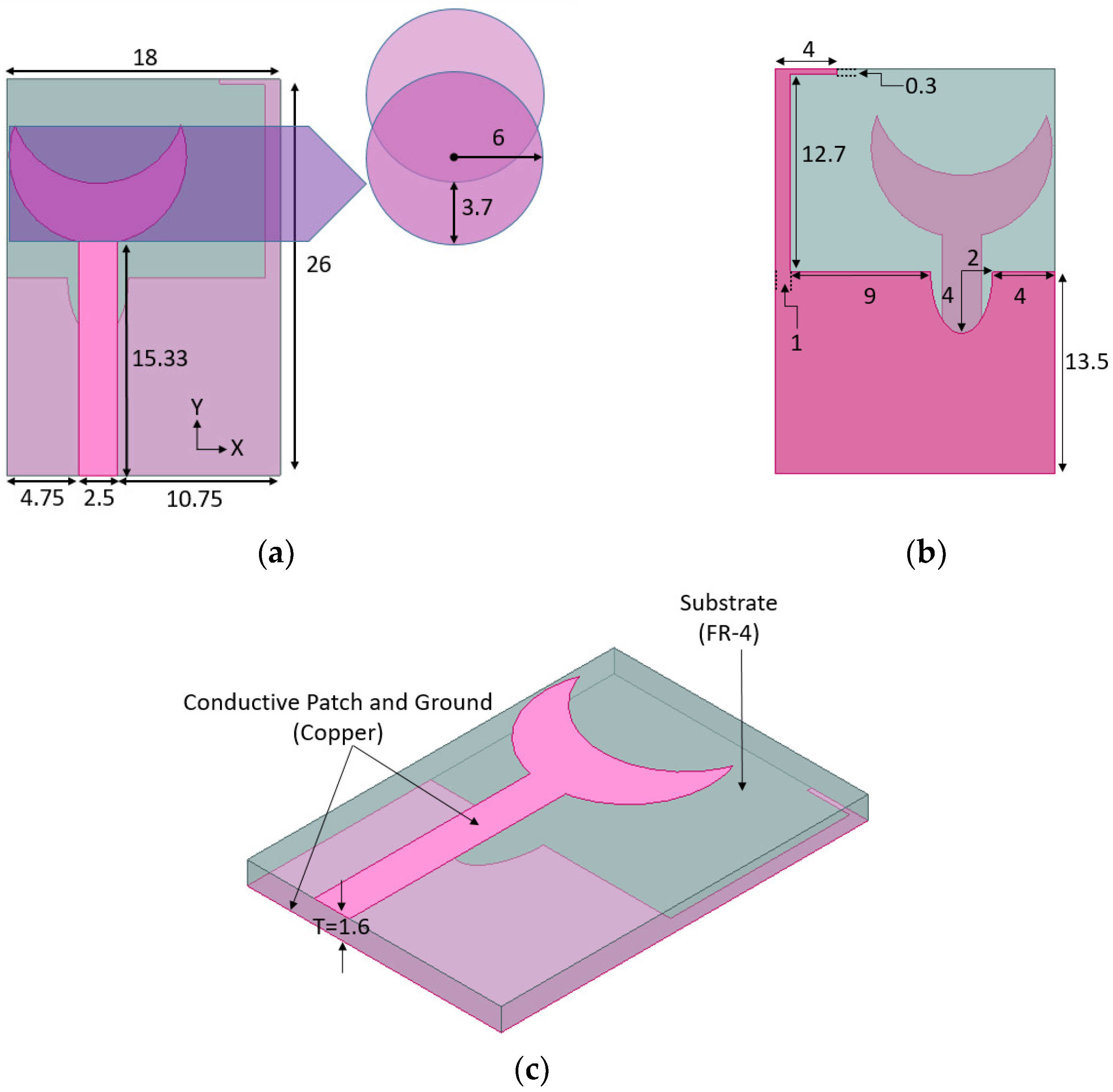
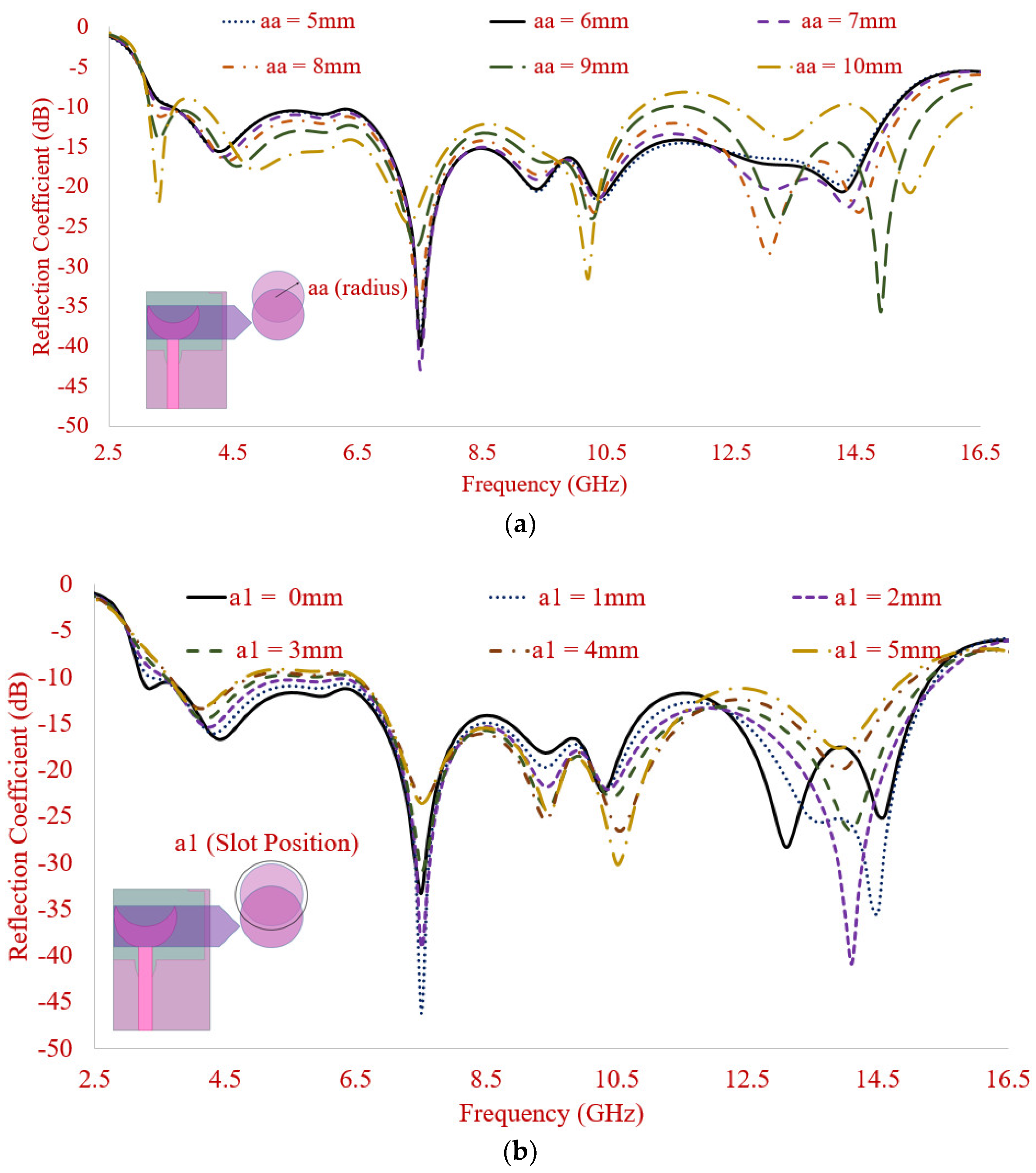


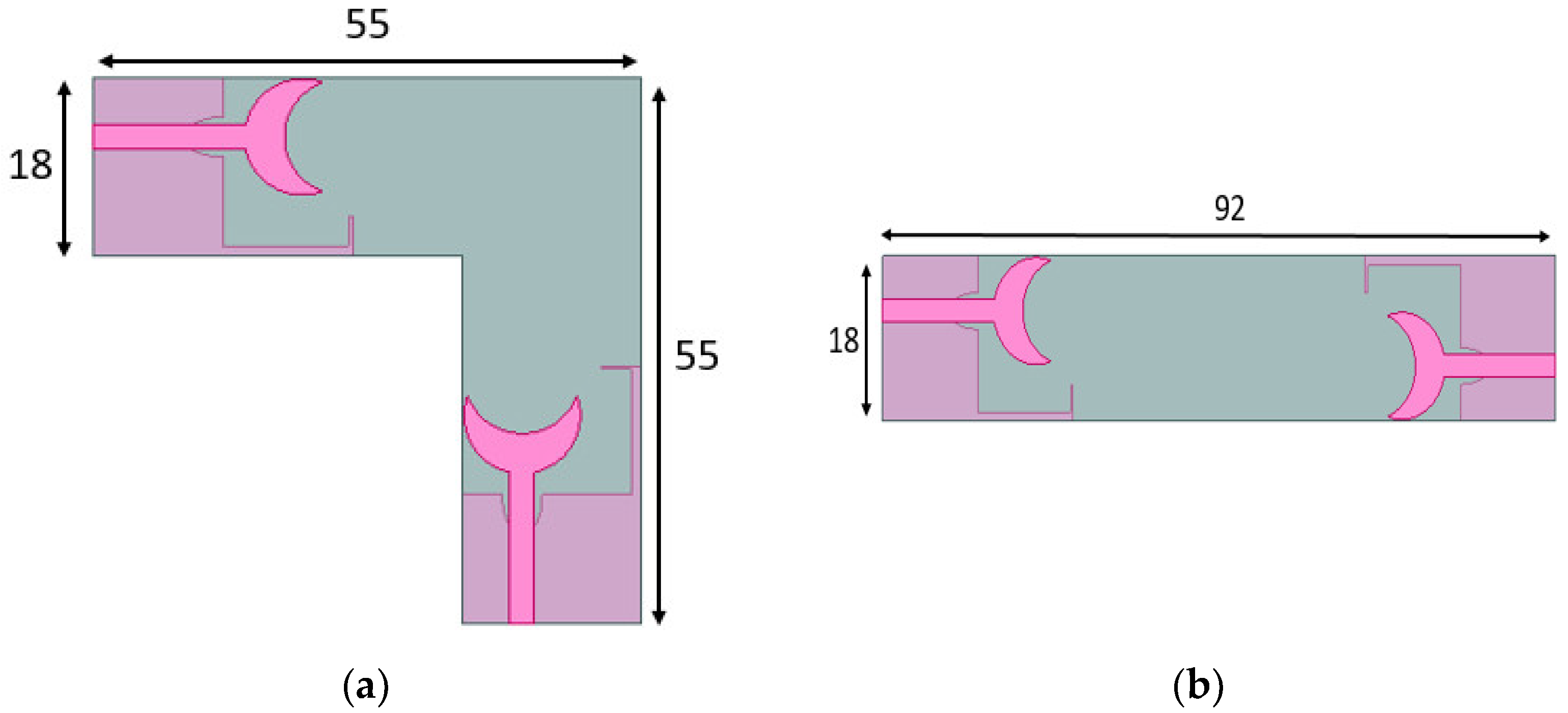

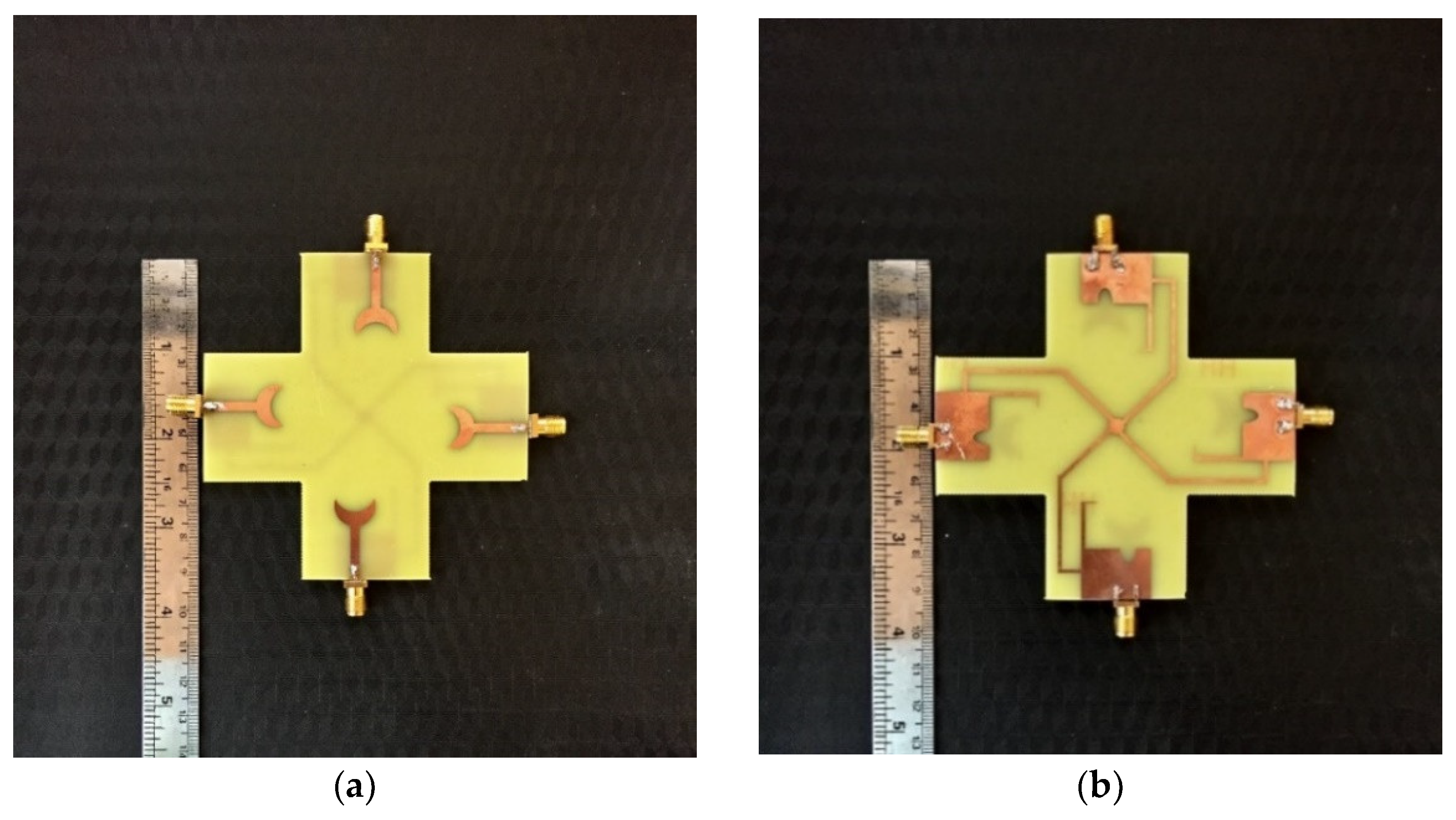
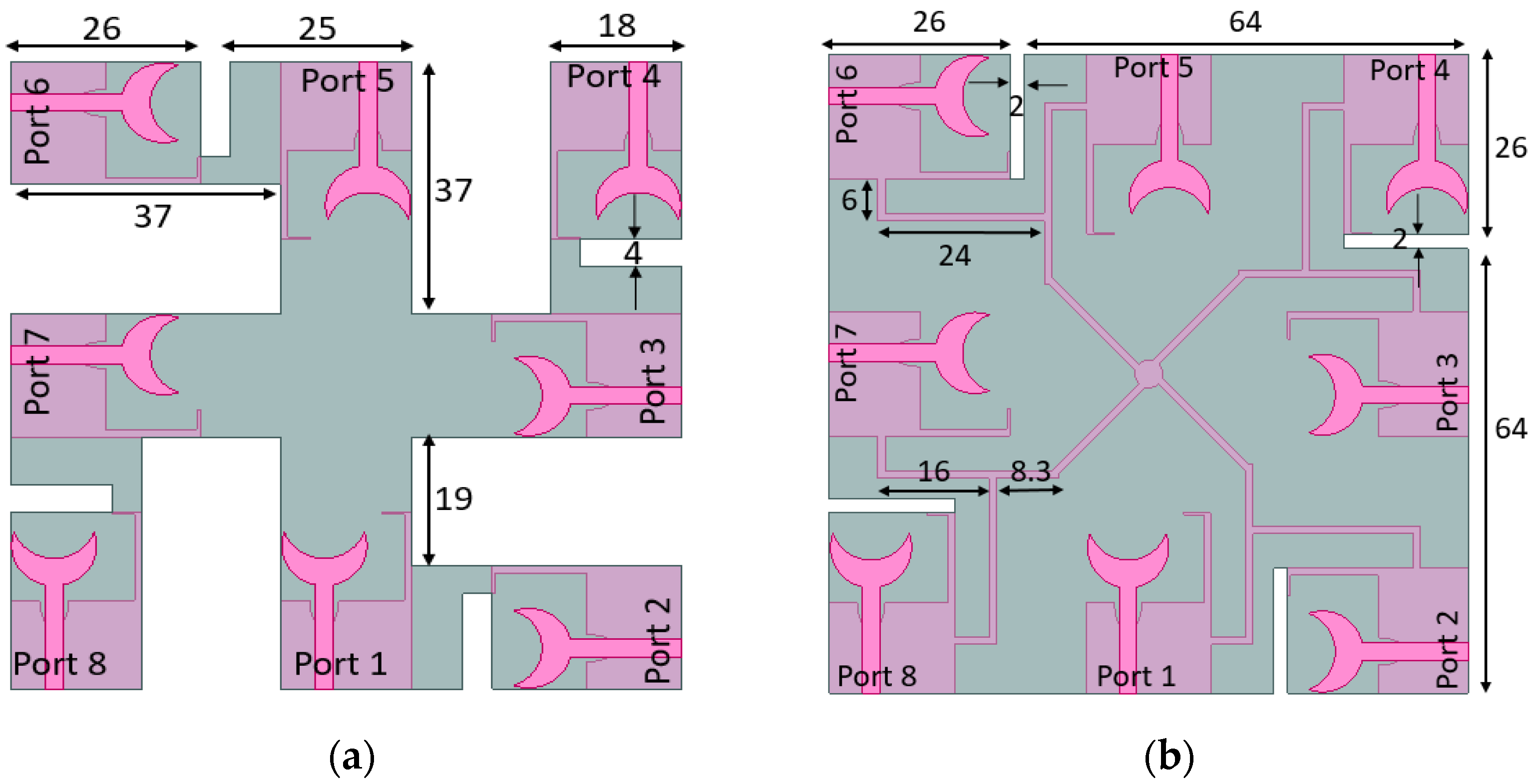

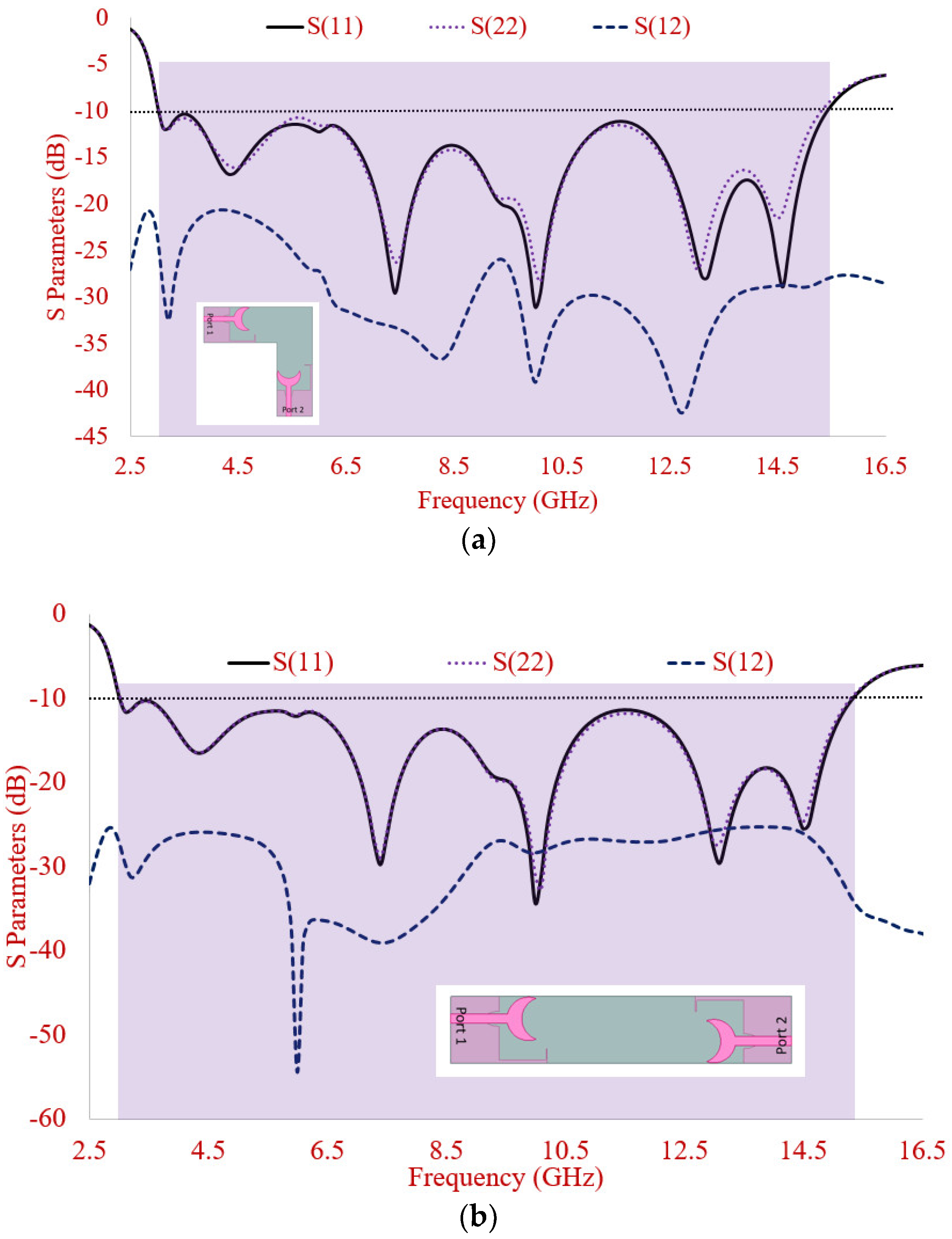
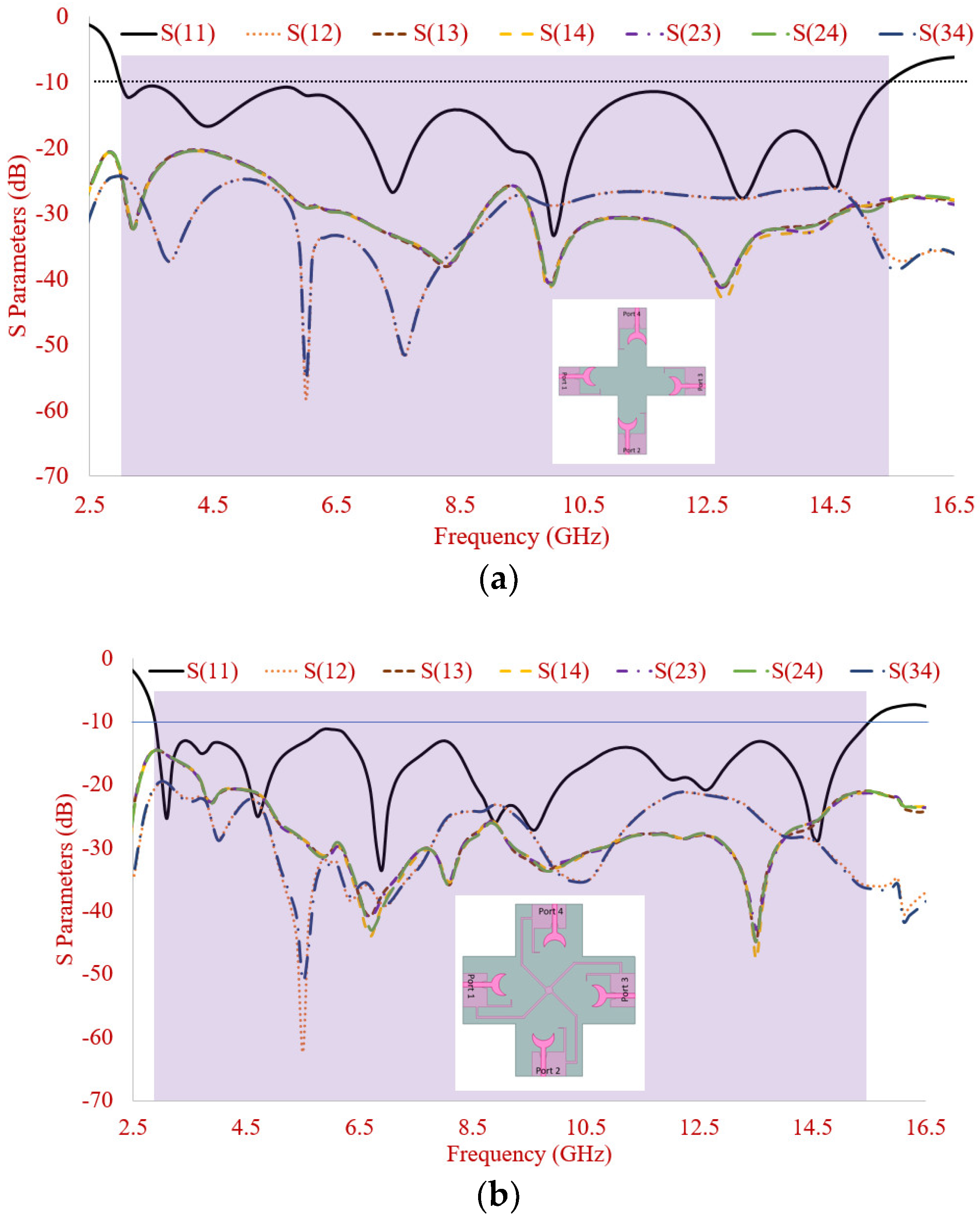
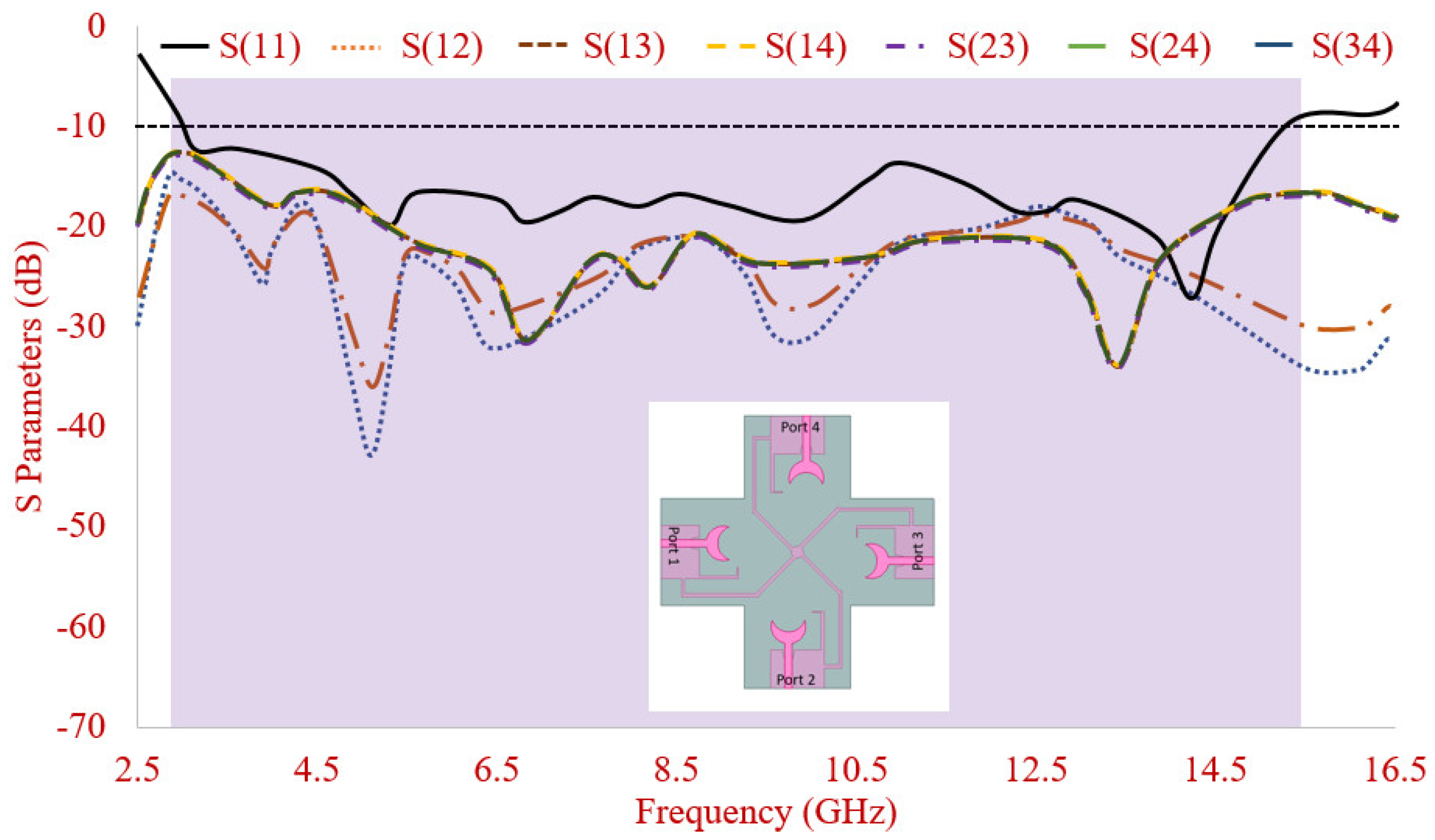
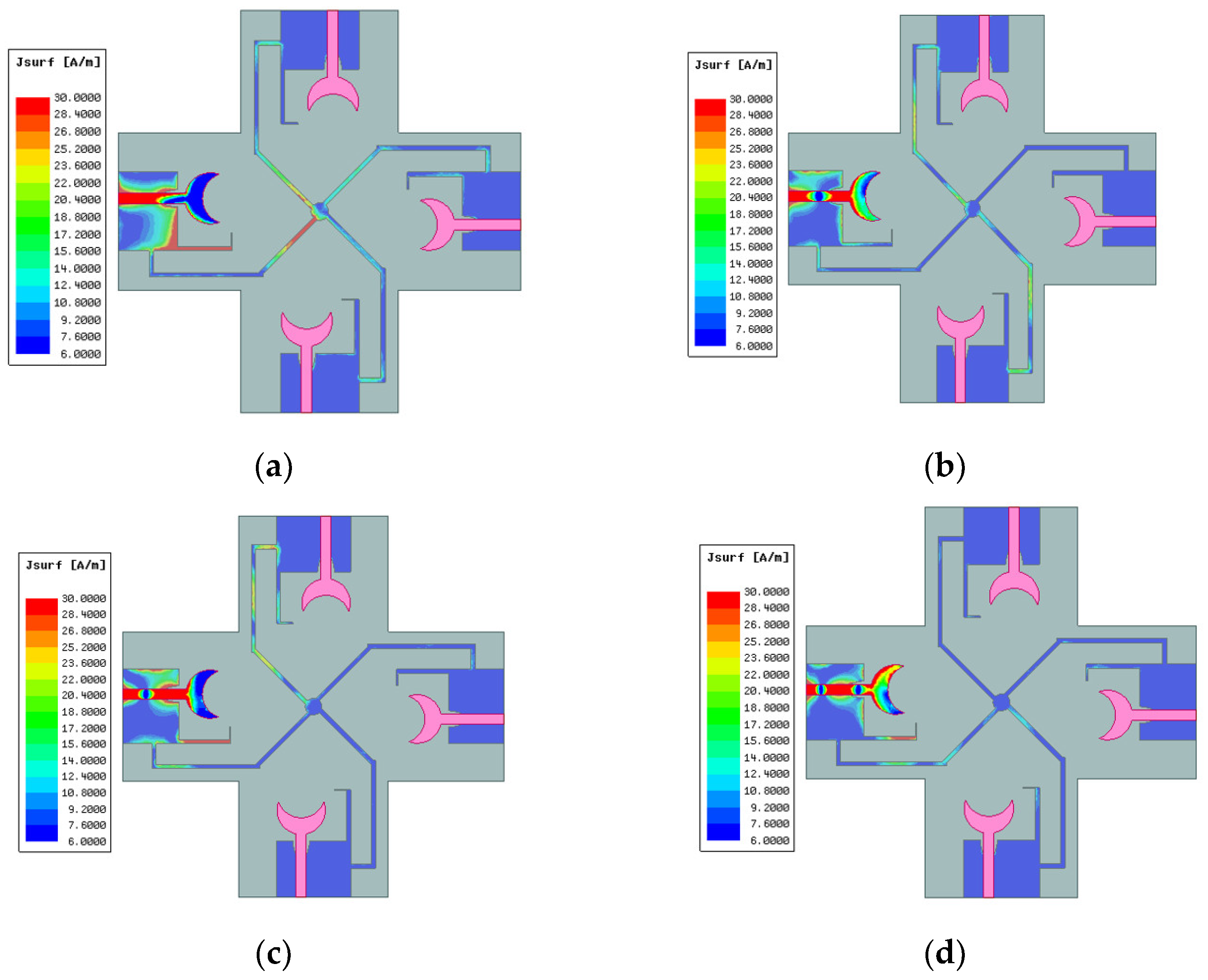


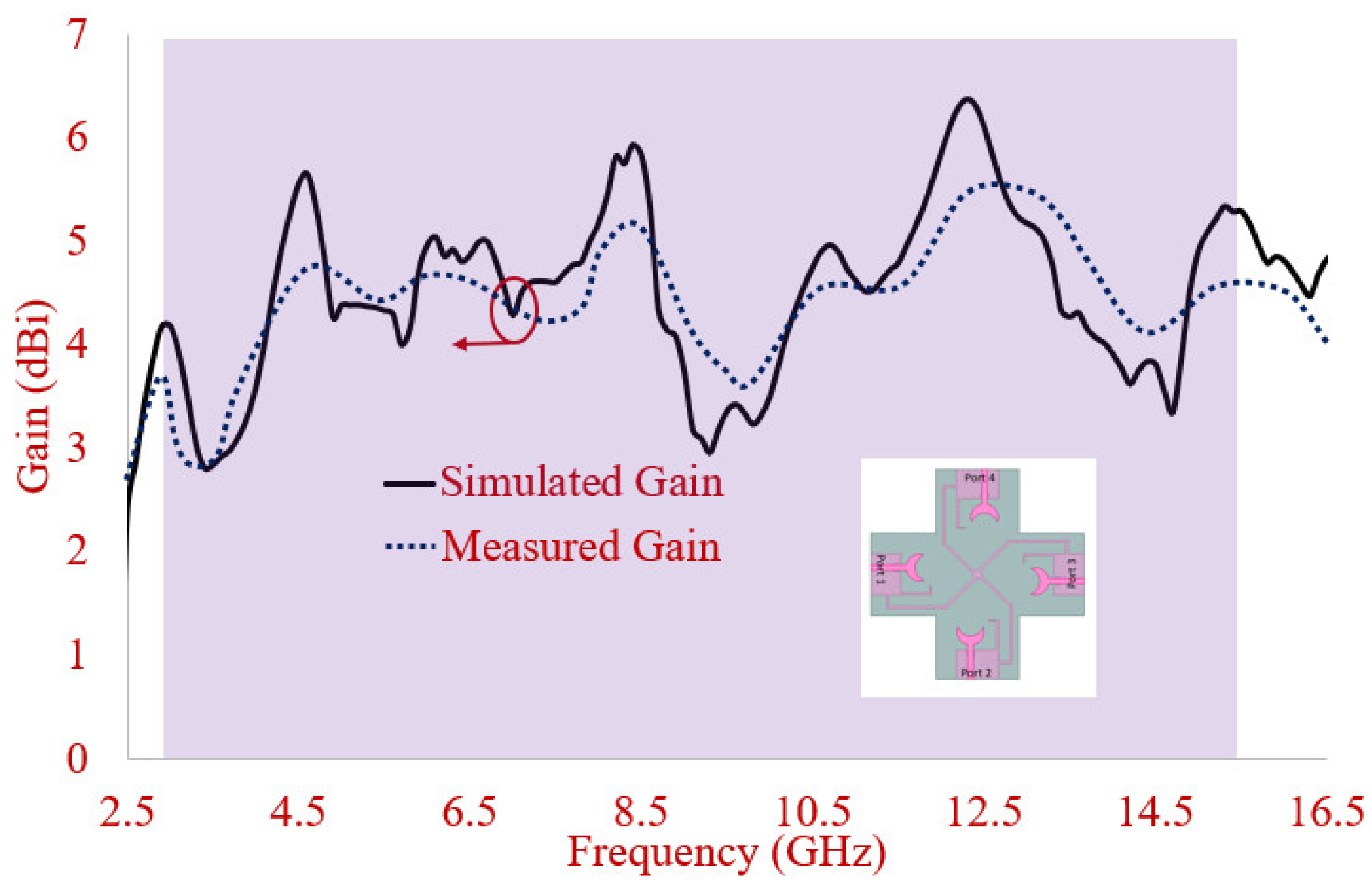

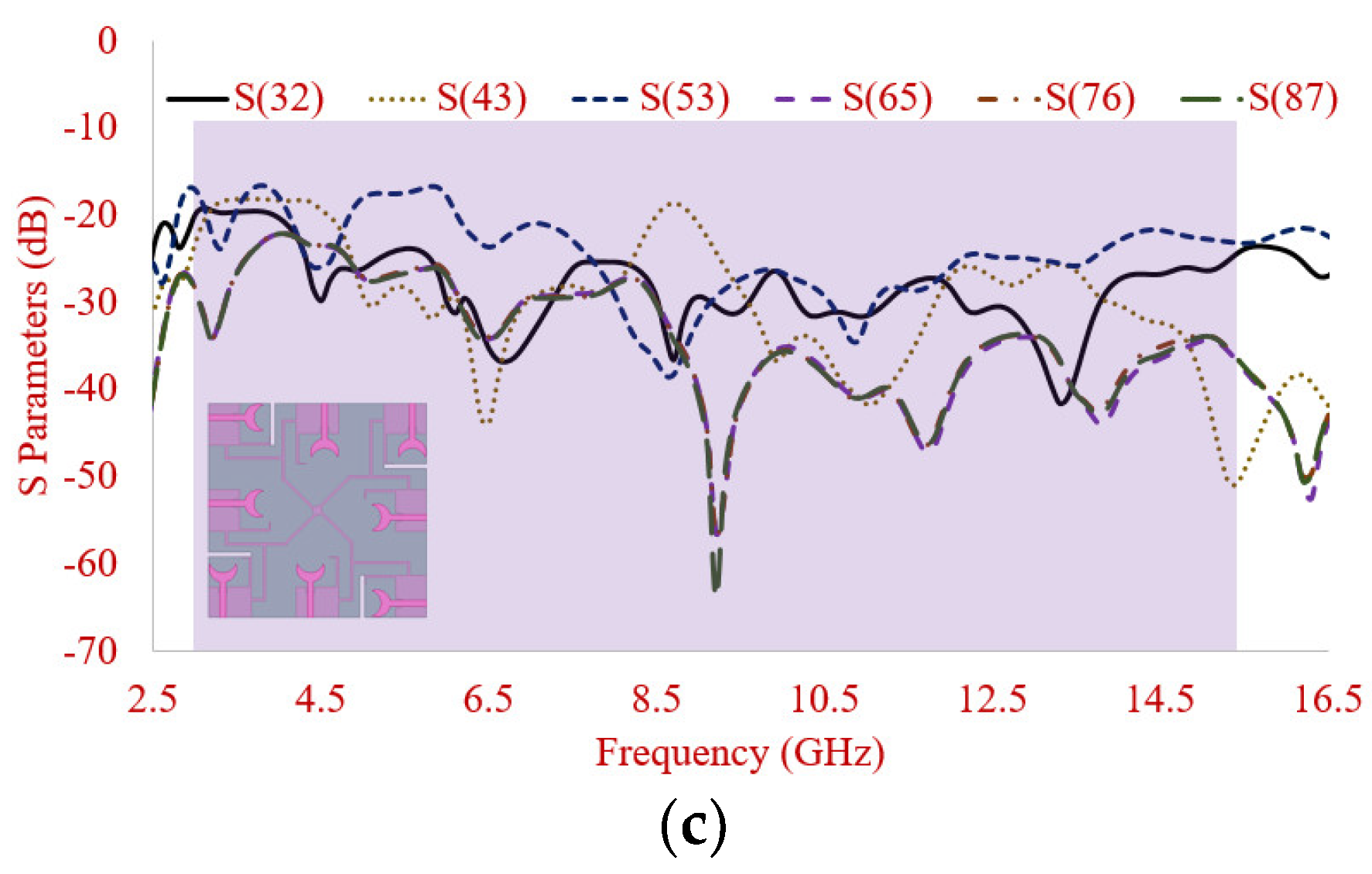
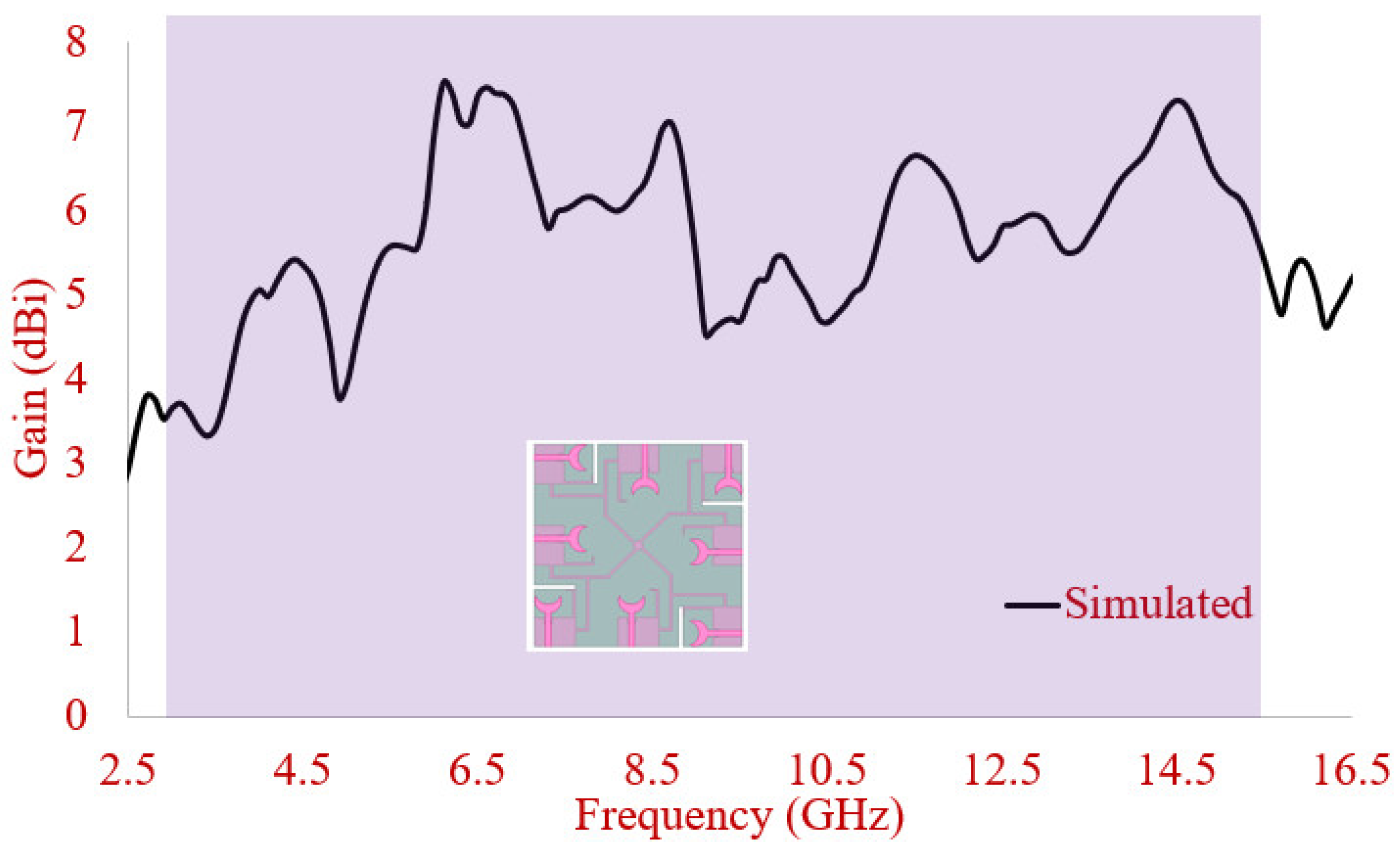

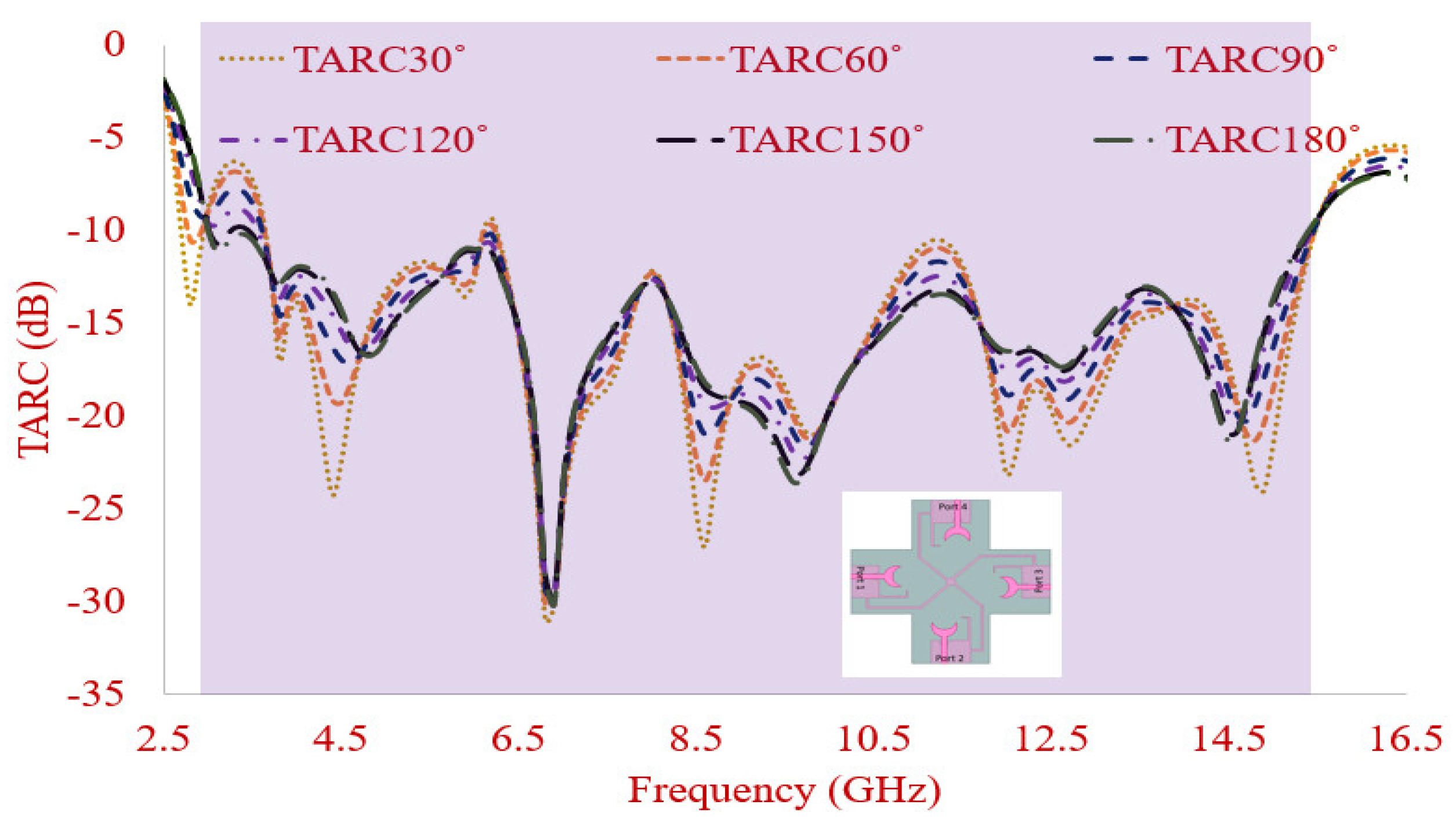
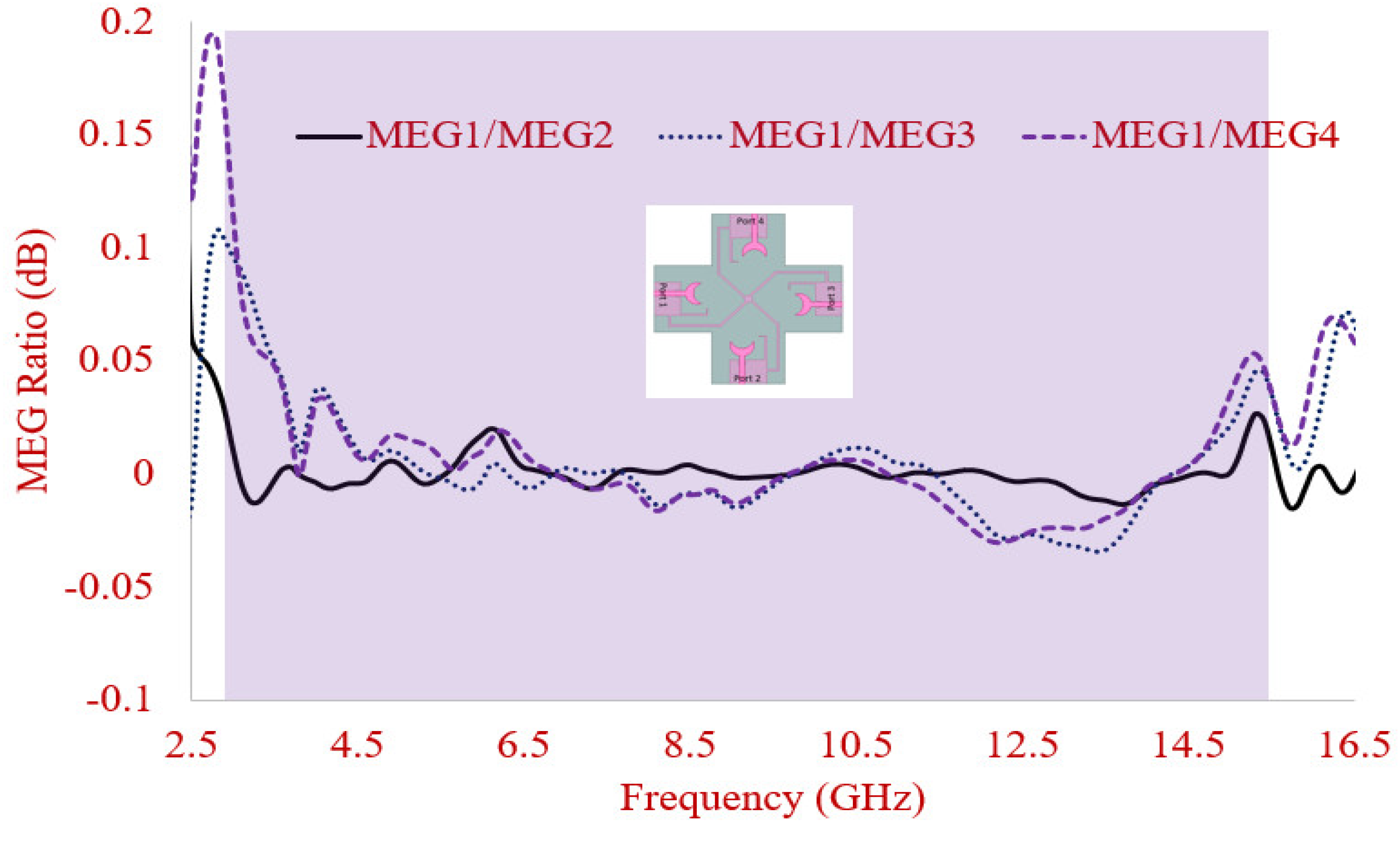
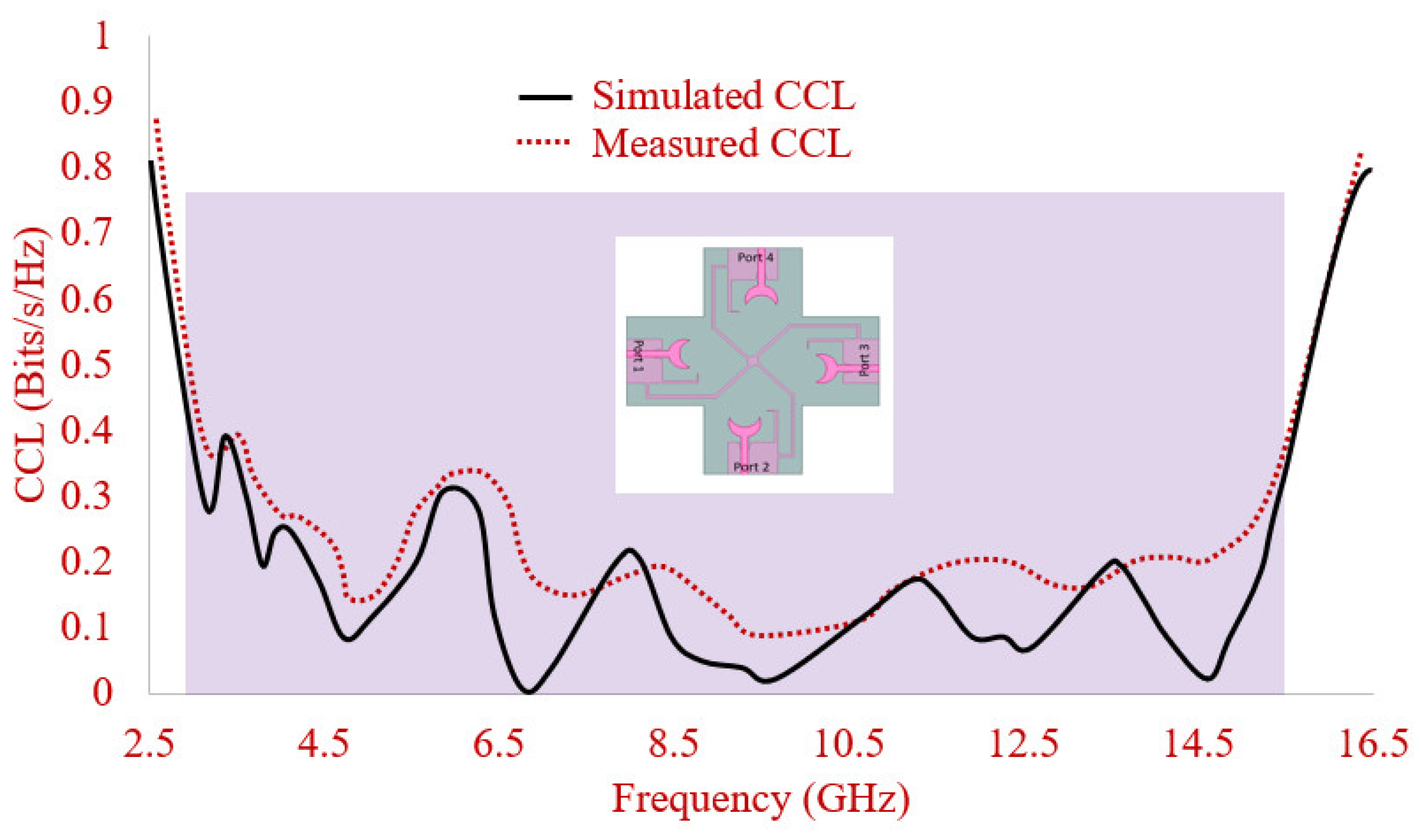
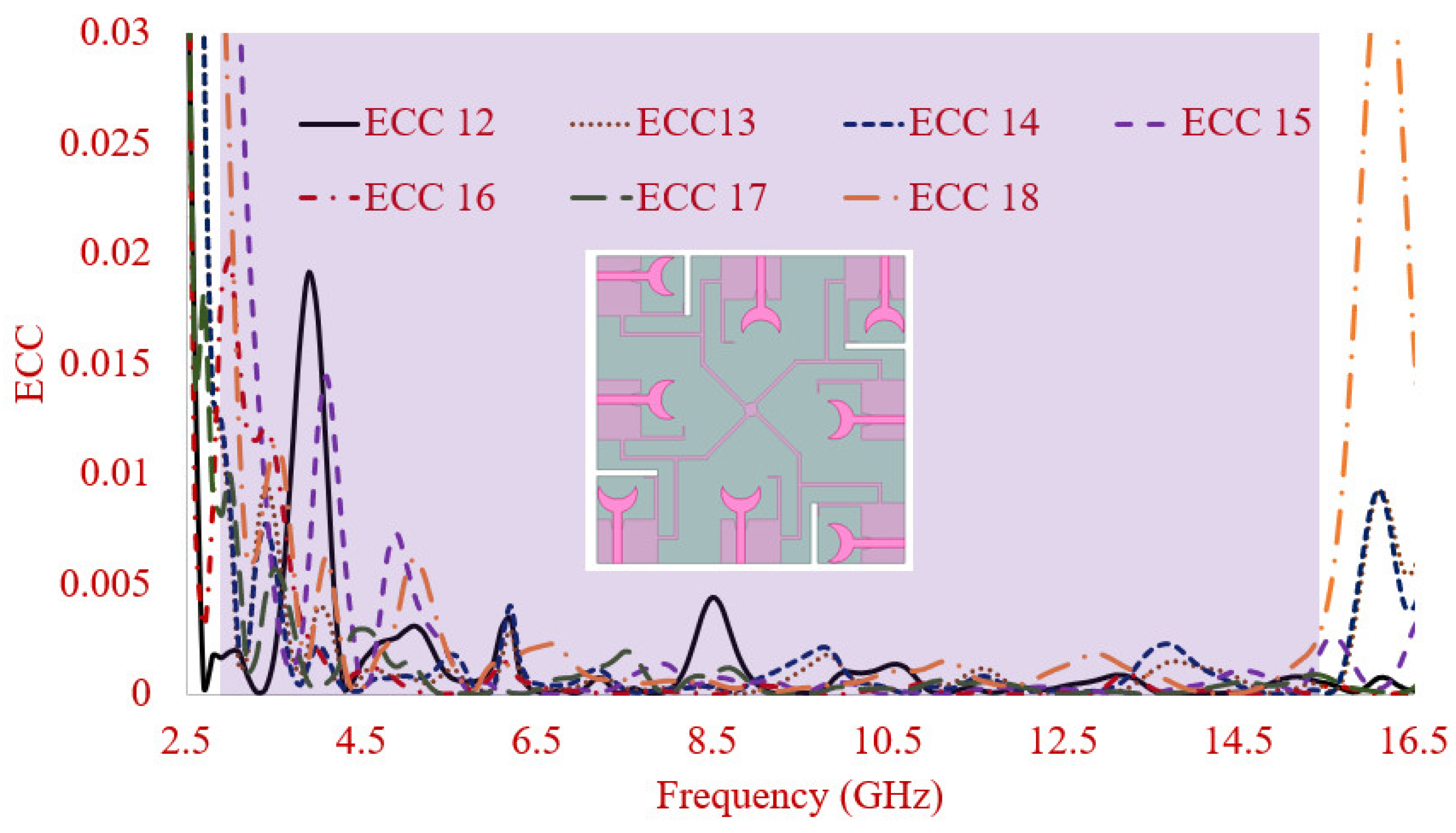
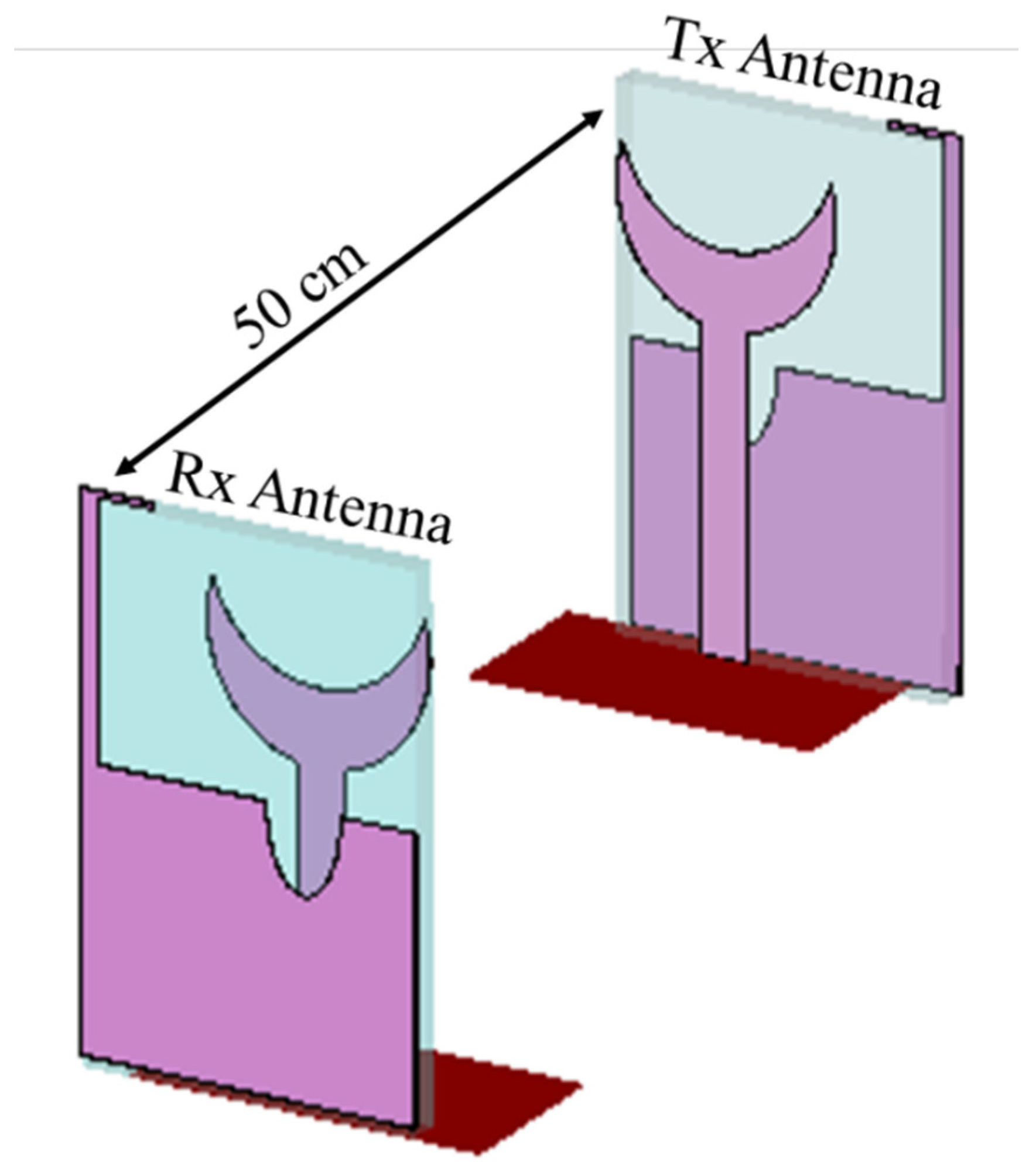

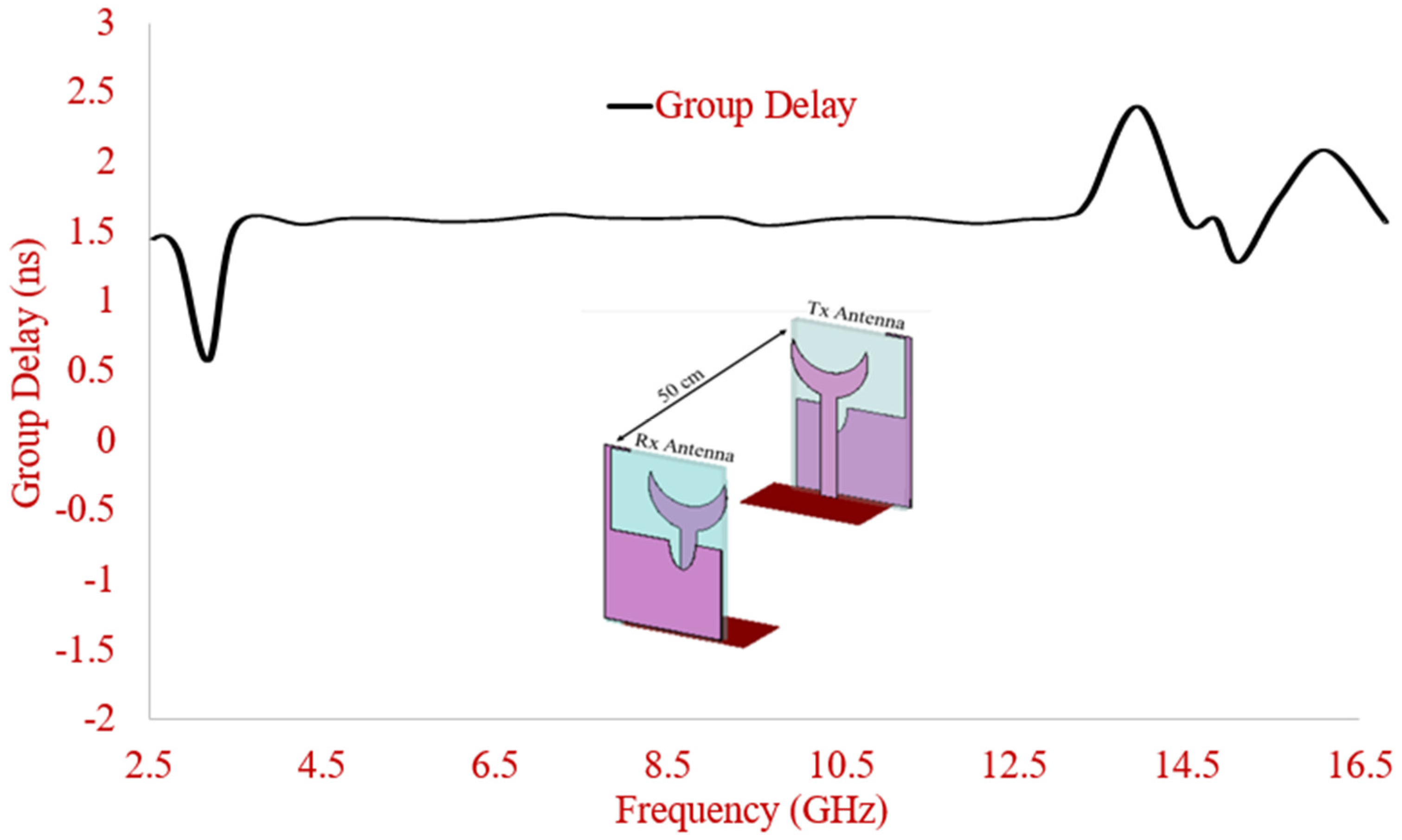
| Ref. No | No of Elements | Size (mm2) (At Lowest Freq) | Operating Band (GHz) | Isolation (dB) | Isolating Element | Peak Gain (dBi) | ECC |
|---|---|---|---|---|---|---|---|
| [12] | 8 | 0.41 λ × 0.41 λ | 3.1–11 | >20 | Not Used | 4 | <0.01 |
| [13] | 4 | 0.41 λ × 0.44 λ | 3.1–10.6 | >20 | Microstrip Multimode Resonator | 4 | <0.2 |
| [15] | 4 | 0.77 λ × 0.77 λ | 3.1–17.3 | >13.5 | Neutralization Ring | 5.6 | <0.1 |
| [16] | 4 | 0.67 λ × 0.67 λ | 2.8–13.3 | >18 | Rectangular Strip | 6 | <0.06 |
| [17] | 4 | 0.15 λ × 0.3 λ | 0.75–7.65 | >12 | Not used | 3.2 | <0.24 |
| [18] | 4 | 0.45 λ × 0.26 λ | 3.2–12 | >22 | Not used | 4 | <0.5 |
| [20] | 4 | 0.56 λ × 0.39 λ | (3.52–10.08) | >22 | Neutralization Line | 2.91 | <0.04 |
| [21] | 4 | 0.44 λ × 0.44 λ | 3.8–15 | >15 | Ground Stubs | 3 | <0.07 |
| [26] | 8 | 1.65 λ × 0.82 λ | 4.95−5.05 | >10.5 | Spatial Diversity | 0.8 | -- |
| [27] | 8 | 1.24 λ × 0.62 λ | 3.4−3.6 | >10 | CL-FSS, circular arcs, and four parallel strips | -- | -- |
| [28] | 8 | 0.6 λ × 0.93 λ | 3−10.6 | >15 | square loop radiating strip with orthogonal polarisation | -- | -- |
| [29] | 8 | 0.56 λ × 1.13 λ | 2.5−2.6 | >15 | Eight grounded Slits | 0.7 | <0.2 |
| [30] | 8 | 0.75 λ × 1.5 λ | 3.3−6 | >11 | Not used | -- | <0.1 |
| [31] | 8 | 0.85 λ × 0.85 λ | 3−10.6 | >15 | Rectangular stub | 4.8 | <0.2 |
| Proposed | 8 | 0.61 λ × 0.61 λ | 2.84–11 (effective BW) | >15 | Not Used | 7.2 | <0.02 |
Publisher’s Note: MDPI stays neutral with regard to jurisdictional claims in published maps and institutional affiliations. |
© 2021 by the authors. Licensee MDPI, Basel, Switzerland. This article is an open access article distributed under the terms and conditions of the Creative Commons Attribution (CC BY) license (https://creativecommons.org/licenses/by/4.0/).
Share and Cite
Addepalli, T.; Desai, A.; Elfergani, I.; Anveshkumar, N.; Kulkarni, J.; Zebiri, C.; Rodriguez, J.; Abd-Alhameed, R. 8-Port Semi-Circular Arc MIMO Antenna with an Inverted L-Strip Loaded Connected Ground for UWB Applications. Electronics 2021, 10, 1476. https://doi.org/10.3390/electronics10121476
Addepalli T, Desai A, Elfergani I, Anveshkumar N, Kulkarni J, Zebiri C, Rodriguez J, Abd-Alhameed R. 8-Port Semi-Circular Arc MIMO Antenna with an Inverted L-Strip Loaded Connected Ground for UWB Applications. Electronics. 2021; 10(12):1476. https://doi.org/10.3390/electronics10121476
Chicago/Turabian StyleAddepalli, Tathababu, Arpan Desai, Issa Elfergani, N. Anveshkumar, Jayshri Kulkarni, Chemseddine Zebiri, Jonathan Rodriguez, and Raed Abd-Alhameed. 2021. "8-Port Semi-Circular Arc MIMO Antenna with an Inverted L-Strip Loaded Connected Ground for UWB Applications" Electronics 10, no. 12: 1476. https://doi.org/10.3390/electronics10121476
APA StyleAddepalli, T., Desai, A., Elfergani, I., Anveshkumar, N., Kulkarni, J., Zebiri, C., Rodriguez, J., & Abd-Alhameed, R. (2021). 8-Port Semi-Circular Arc MIMO Antenna with an Inverted L-Strip Loaded Connected Ground for UWB Applications. Electronics, 10(12), 1476. https://doi.org/10.3390/electronics10121476











